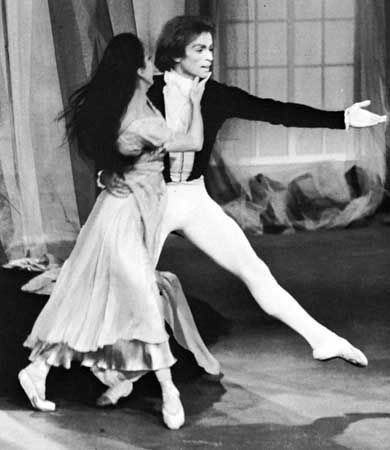Rudolf Nureyev, born on March 17, 1938, and passing away on January 6, 1993, remains an iconic figure in the world of ballet. This celebrated ballet dancer, originally from Irkutsk, Russia, then part of the U.S.S.R., captivated audiences worldwide with his breathtaking leaps, rapid turns, and intensely charismatic stage presence. Often compared to the legendary Vaslav Nijinsky, Nureyev not only revived the prominence of male roles in ballet but also broadened the art form’s appeal to a global audience.
Growing up in Ufa, the capital of the Bashkir Autonomous Soviet Socialist Republic, Nureyev’s Tatar heritage and early life in Soviet Russia shaped his determined and rebellious character. He began his ballet journey relatively late at age 11. By 15, his passion led him to leave school and support himself through dance, demonstrating an early commitment to his art. At 17, he was accepted into the prestigious Leningrad Ballet School, where he studied under the esteemed teacher Aleksandr Pushkin. Even in this rigorous environment, Nureyev stood out as a brilliant yet nonconformist student. He defied Soviet norms by refusing to join the Komsomol, breaking curfew, and learning English in secret, hinting at his independent spirit and desire for a wider world.
Upon graduating in 1958, Nureyev quickly ascended to soloist status with the renowned Leningrad Kirov Ballet (now Mariinsky Ballet). He excelled in leading roles, touring internationally with the company and garnering acclaim. However, the rigid confines of the Soviet ballet system began to stifle his artistic ambitions. During a pivotal Kirov Ballet tour to Paris in June 1961, Nureyev made a life-altering decision. He famously evaded Soviet security at Le Bourget Airport and sought asylum in France. His defection sent shockwaves through the ballet world and the Soviet Union. Nureyev later explained that his dramatic escape was driven by a yearning for artistic freedom – the desire to dance more frequently, explore diverse roles, and escape the limitations imposed by the Soviet ballet establishment.
 Rudolf Nureyev in full costume performing ballet
Rudolf Nureyev in full costume performing ballet
Rudolf Nureyev, a celebrated ballet dancer, performing in an elaborate costume, highlighting his dramatic stage presence and technical skill.
Following his defection, Nureyev immediately immersed himself in the Western ballet scene. He joined the Grand Ballet du Marquis de Cuevas and made his American television debut in 1962, further expanding his reach. He also performed with Ruth Page’s Chicago Opera Ballet, quickly establishing himself as a captivating international star. Later in 1962, he formed a significant and enduring partnership with the Royal Ballet in London as a permanent guest artist. Interestingly, Nureyev intentionally chose not to become a permanent member of any single major Western company. This strategic decision allowed him unparalleled freedom to collaborate with a wide array of companies and choreographers across the globe, constantly pushing his artistic boundaries.
Nureyev’s name became inextricably linked with Dame Margot Fonteyn, forming one of ballet’s most legendary partnerships. Their on-stage chemistry was magnetic, and together they redefined iconic roles such as Albrecht in Giselle, Armand in Marguerite and Armand, and Prince Siegfried in Swan Lake. Nureyev was not only a sought-after performer but also a visionary choreographer. He restaged Swan Lake for the Vienna State Opera in 1964, notably enhancing the male dancer’s role, reflecting his career-long mission to elevate male ballet. His choreographic talents extended to Sergey Prokofiev’s Romeo and Juliet, which premiered with the London Festival Ballet in 1977, and Manfred for the Paris Opéra Ballet in 1979, showcasing his depth and versatility as an artist. In the 1980s, his choreographic energy continued with The Nutcracker for the Berlin Ballet (1980) and a celebrated version of Romeo and Juliet at La Scala (1981), famously reuniting with Fonteyn as Lady Capulet. Beyond classical ballet, Nureyev embraced modern repertoires, performing works by choreographic giants like Martha Graham, Murray Louis, and Paul Taylor. Martha Graham even created the role of Lucifer (1975) specifically for him, and he premiered Louis’s Canarsie Venus and Vivace in America in 1978, demonstrating his openness to new artistic expressions.
In addition to his stage work, Nureyev ventured into film. He co-directed and starred in a film adaptation of Don Quixote (1973) and took on acting roles in Valentino (1977) and Exposed (1983), revealing his multifaceted artistic talents. His autobiography, simply titled Nureyev, was published in 1962, offering insights into his life and artistic philosophy.
Nureyev’s contributions to ballet were officially recognized when he became an Austrian citizen in 1982. From 1983 to 1989, he served as the artistic director of the prestigious Paris Opéra Ballet, further solidifying his influence on the dance world. Even as he faced declining health due to AIDS-related complications, he continued to choreograph for both the American Ballet Theatre and the Paris Opéra Ballet, driven by an unwavering passion for his art. Rudolf Nureyev passed away in Paris in 1993 at the age of 54, leaving behind an unparalleled legacy. He is remembered not only as one of the greatest ballet dancers of all time but also as a cultural icon who defied political boundaries and redefined the landscape of male ballet, captivating generations with his artistry and charisma.

